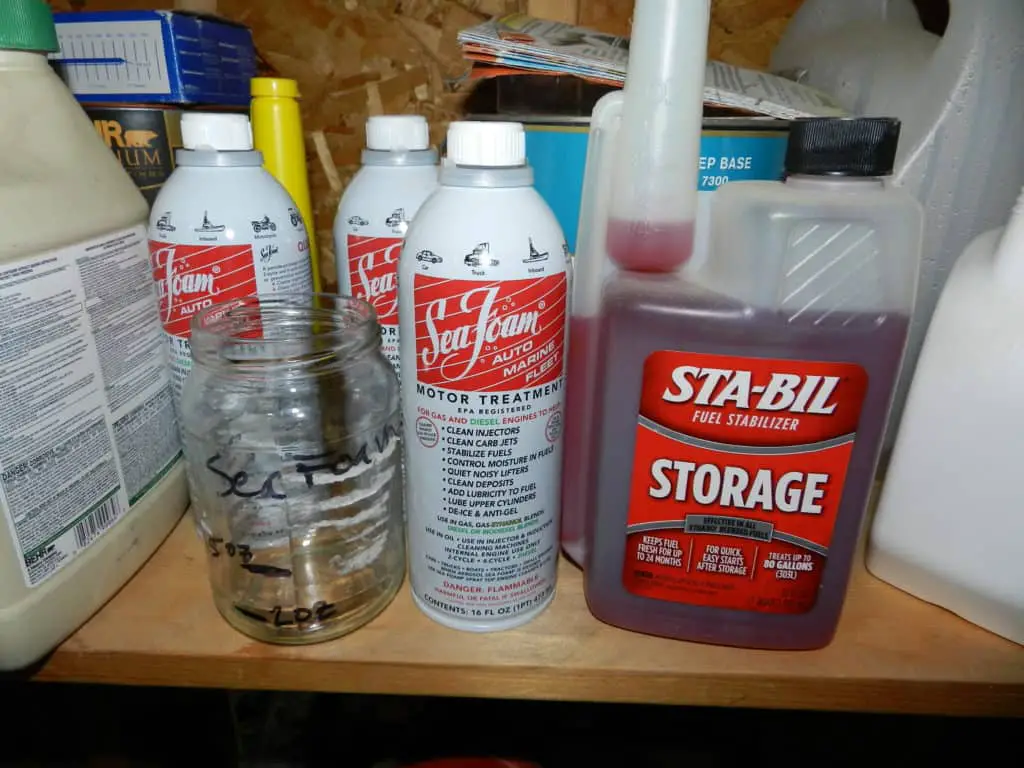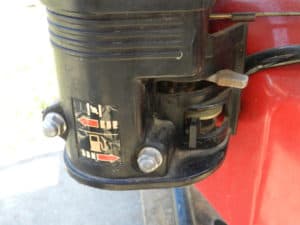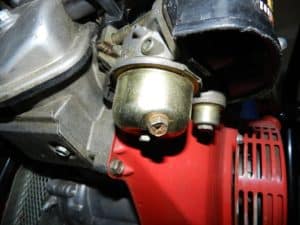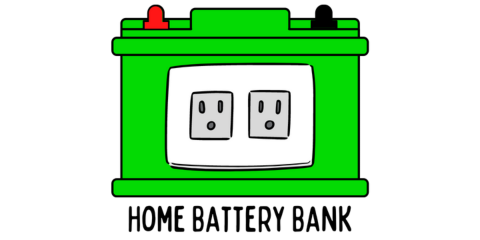Now that you’ve acquired your first generator and are high on that enormous sense of relief that it brings, you are left with a controversial question: should I store a generator with or without gas inside of it?
With a quick Google search, you’ll find dire warnings making you aware of everything from fuel type, brand of additives, power-down procedures, and more.
The two-pronged answer to the question of this post is: 1.) Yes, you can successfully store a generator long-term with gasoline in it IF you are willing to spend 15 minutes to let it run and power something with it every month or two. 2.) No, you likely will not store your generator successfully with gasoline in it if you are going to neglect it for months and months or even years on end.
So, the answer ultimately hinges upon your willingness to commit a little time to this device that can be a lifesaver in a power outage or emergency.
Don’t judge yourself one way or the other. There isn’t a right or wrong answer, you just need to be honest about the time commitment you’re going to make so that you don’t harm the generator in the storage process and make more problems down the road when you actually need to run it and it won’t start.
I’m going to cover fuel type and fuel stabilizer selection as well as storage for both styles of ownership — giving it a little of your time every month or two, or simply “set it and forget it”. This article will deal only with gasoline-powered generators and not those powered by other means.
Type of Fuel for Generator Storage
Let’s start by looking at the cornerstone of whatever method we’re going to teach later in the article. The cornerstone of your storage method is going to be the fuel type that you use. By that, I mean regular unleaded gasoline vs. ethanol-free gasoline (RV gas) which is a little costlier.
With all of my outdoor items (except my lawnmower usually, but I will probably start this year) I use ethanol free gasoline in their gas tanks.
Regular, unleaded gasoline has about 10% ethanol blended into it and does a great job in most engines if used right away. Without treatment, it is not designed for long-term storage because the ethanol in the gasoline will bond with moisture (water molecules) in the air and start to corrupt the integrity of your gasoline.
Not only that, you’ll lose to volatile properties of the gasoline to evaporation over time as it sits in storage (without treatment). Finally, the air just loves to oxidize anything and everything. It’s essentially why anything in this world naturally dies — it oxidizes.
Gasoline, when oxidized, experiences chemical reactions between the oxygen in the air and the hydrocarbons in the gasoline. The chemical structure of the gasoline begins to change and deposits are formed in your fuel lines and system. This makes for hard starts, no starts, or stalls down the road.
So, what are we to do? Use ethanol free gasoline if possible! Untreated ethanol-free gasoline will still experience the oxidation process and lose volatility but at a slower rate but you will still certainly want to stabilize it and not let it sit for long in storage without doing so. Ethanol-free gas will also not want to absorb moisture from the air like its counterpart.
Where can you buy ethanol-free gasoline? That is a good question. In my county, the closest place is about 15 miles away and it is the only one! You can check out this link (https://www.pure-gas.org/extensions/map.html) which will take you to a google map overlay and will show you the places in the US and Canada where you can pick up some fuel for your generator. I recommend finding the gas station’s phone number and calling to double check before you make the trip.
Expect treated gasoline of either type to stay good for up to one year. If you don’t end up using it, you can disconnect a fuel line and drain it into a gas can to dump into your car’s gas tank.
Again though, if you use regular unleaded with ethanol in it, you run the risk of clogging up your carburetor, fuel lines, etc. and bringing in a higher concentration of water into your fuel mix. Please use ethanol free to keep your generator experience as hassle-free as possible. We’re talking about using your generator when it matters — when it’s dark, cold, and stressful. Set yourself up for success ahead of time!
Fuel Treatment Options
This is a topic that gets just about as heated online as to whether or not to store a generator with or without gas! Fuel stabilizers protect the integrity of the gasoline (both unleaded and ethanol free) from oxidation and moisture.
Two of the more popular options out there that are easily found at Walmart and other similar stores are Stabil and Sea Foam.

My experience in the matter has only been three years and I have used both products and have not noticed a difference in my generator, lawn mower, or snow blower. I decided to consult one of the best sources of knowledge on the topic that I have access to — my own father.
He has worked with industrial motors and equipment for 40 years and has owned a generator his whole adult life. He has used Stabil brand fuel stabilizer for most of the last 40 years but has recently switched to Sea Foam. It’s not that he has ever had a problem with Stabil — because he hasn’t. He switched to Sea Foam about 3 years ago because it not only protects your gas from oxidizing but it also cleans out your engines in the process. So far, he has no complaints about this product as well.
In all honesty, I don’t think it matters so much which one you pick, but just that you pick one. Just know that if your engine already has some significant gunk built up within it from bad gas, that using either product may loosen it and dislodge it within your system and the new broken up deposits may get clogged up and cause problems. It’s not that the product itself clogged your engine, it’s just that it broke up the build-up that was already occurring.
Storing Your Generator WITH Gasoline In It
Now if you’re planning on paying you generator some attention a dozen or so times throughout the year, here are the following steps that I take to keep my unit in proper working order.
I was taught these by my father, who for 40 years has never experienced a single problem starting a generator — and he always stores it with fuel in the tank.
This method works by regularly cycling fuel through generator’s engine and makes sure that things don’t stay static very long, which would allow for gunk to build-up. Having gasoline in the generator also ensures that it will be ready at a moment’s notice when the need arises. Here’s the process to ensure a successful start-up every time!
- Make sure to keep track of your oil changes and know where you’re at regarding the next one. Use a magic marker and write on a piece of duct tape the last time that you changed the oil. also right on a piece of duct tape the type of oil that you use for your oil changes as well as the exact quantity of oil needed. If working with generators is not your normal daily activity you’ll thank yourself later for doing this. I use 10w-30 weight oil for mine.
- Assuming that the oil is fine, you’re going to want to take your generator out for a cheap date every month or so. You can bring the beer or coffee and you can do all the talking. Your generator just wants to know that you care. You’re going to take it outside so that the carbon monoxide fumes will be away from the house, and you’re going to want to start up your generator and let it get warmed-up.
- If you’re new to starting an engine, make sure the engine switch is “on”, close the “choke” lever, and open the fuel valve lever to allow fuel to flow.


The “choke” lever (when turned on/closed) restricts the amount of gasoline that is permitted in the carburetor. With a higher gas-to-air ratio, the engine will start up easier in colder weather due to the richer gasoline environment for the spark plugs to ignite (this also applies to “cold starts”, where the temp might be warm but the engine hasn’t been recently running prior to the current startup).
If you stopped the generator to refill with gas, you would not need to use the choke since the engine is already warm and it is no longer a “cold start”. If this is your first time running the generator or if you are just now using treated gasoline, be sure to fill it to the recommended max fill line with the treated gas and proceed to the next step.
You must run the engine for about 10 minutes to cycle through the treated gas through the fuel lines and carburetor. Otherwise, your tank will be protected but the other elements will not and will get stale gasoline. As it is warming up, slowly turn the choke lever to the off/open position to increase the air intake into the carburetor. You’re going to want to run it for at least 10 minutes. You do not need to hook cords to the generator to power anything, but you can if you’d like! Maybe that pot of coffee?
- Consult your owners manual about grounding the generator properly before attempting to deliver power to anything.
After you’ve run it for about 10 minutes or so, you do not want to simply kill the power to the motor and put it back in storage. What you want to do is turn off the fuel valve lever (bottom lever in the picture above — move all the way to the left) to cut off the gasoline to the engine. It will take several minutes for the generator to die because it using up the remaining gasoline that is left in the carburetor.
By doing this process, you clear out the carburetor of any gasoline and prevent the lines and small holes from getting gummed up over time.
With the generator cool, fill the fuel tank to the recommended max fill line(add treated gas to the treated gas already in the tank). This will keep the amount of air to a minimum and will reduce the amount of condensation that will occur inside the fuel tank during temperature swings when stored.
Do not overfill the fuel tank, as the fuel will need room to expand the next time you run the generator and it heats up! Wipe off any debris or dust, and make sure to store your generator in a cool location out of direct sunlight or open flame (appliances with a pilot light, like hot water heaters).
- When using a cover, make sure it is breathable. Plastic covers or drum liners will not allow proper air circulation and can lead to moisture build-up.
Take care of any batteries that might come with your generator by disconnecting them, storing them in an ideal location and charging them properly. Lather, rinse, and repeat every 30 days or so. Simply taking 15 minutes of your time to enjoy a coffee or beer while you let your generator exercise for a little bit will ensure that it is in proper working order the next time the lights go out and you desperately need it to get things restored back to your house quickly as possible.
Storing your generator WITHOUT gasoline in it
No one is judging you if you simply want to buy a generator and set it and forget it. You just need to understand that when you need the generator you’re going to have additional steps to get your generator in working order and you’ll also have additional steps when you’re done using a generator to prepare it for long-term, unattended storage. Here’s what you will want to do if this is your game plan:
- Like before, make sure you are good on your oil changes. If you are going to store the generator for over a year or more, I recommend changing out the oil if it has been used in any working capacity.
- After use, you are going to need to remove the gasoline from the carburetor and fuel tank. You can achieve this by:
- Opening the carburetor drain bolt and then opening the fuel lever valve to drain the fuel from the carburetor and gas tank out into an approved container or basin. Some will have a hose that the fuel will pour out of near the bottom, and some will simply pour it out from where you loosen the drain bolt. It may be best to raise your generator up off the ground with some bricks or boards in order to get a basin to catch the gasoline.

Hand pump the majority of your fuel from the gas tank into a gas can (or just disconnect a fuel line) to then use in your car. A pump like this, seen on Amazon will get the job done for you.
When the majority is pumped out, attempt to start your generator and run it until it dies (assuming you didn’t empty the carburetor bowl). This lets your generator run until it runs out of fuel.
Remove the spark plug cap and use a properly sized socket or a spark plug tool to remove the spark plug. Wipe it down and pour about a tablespoon of new engine oil into where the spark plug was seated. With the spark plug still disconnected, gently pull the starter cord a couple of times to get the oil circulated in the cylinder.
Reattach the spark plug. Take care of any batteries that might come with your generator by disconnecting them, storing them in an ideal location and charging them properly. With the generator cool, wipe off any debris or dust, and make sure to store your generator in a cool location out of direct sunlight or open flame (appliances with a pilot light, like hot water heaters).
- When using a cover, make sure it is breathable. Plastic covers or drum liners will not allow proper air circulation and can lead to moisture build-up.
Conclusion
To a newbie, generators can seem a bit intimidating and they should certainly be treated with a healthy level of respect. Be sure to consult your manual regarding “grounding” requirements. Remember that after you use the generator and are getting it ready for storage that the muffler will be extremely hot and will cause serious burns if touched.
I learned this lesson when picking up a lawnmower many many years ago to load it into the bed of a truck. I had a severe burn covering half of my inner forearm.
Be honest with yourself about the level of commitment that you are going to show your generator throughout the year and take the appropriate steps to take care of it so that it will take care of you the next time your power goes out.
You’ll rest easy knowing that you’ve done everything in your power to maximize your chances of coasting through the next blackout! There’s nothing like starting your generator on the first pull of the cord! I hope this article helps you out!
